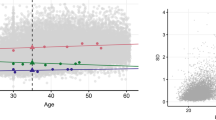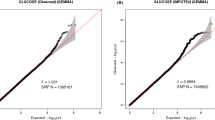Abstract
Aims/hypothesis. To estimate the heritability of insulin sensitivity and insulin secretion, both of which are considered to contribute to the development of Type II (non-insulin-dependent) diabetes mellitus.¶Methods. Intraclass correlation coefficients and heritability estimates for insulin sensitivity (euglycaemic clamp) as well as first-phase and late-phase insulin secretion (intravenous glucose tolerance test) were calculated in 21 monozygotic and 20 dizygotic twin pairs of the same sex between 54 and 72 years of age.¶Results. Intrapair correlations for all traits were consistently higher in monozygotic than in dizygotic pairs. Insulin secretion correlated significantly only between monozygotic (first-phase r = 0.55; p = 0.003 and late-phase r = 0.66; p < 0.001) twins giving heritability estimates of 0.55 and 0.58, respectively. Insulin-stimulated glucose uptake showed a more modest correlation between monozygotic twins (r = 0.46; p = 0.015). The heritability estimate was 0.37. The heritability estimate for waist-to-hip ratio was 0.76 in female and 0.70 in male twins.¶Conclusion/interpretation. Genetic variability seems to contribute to the variance of insulin sensitivity as well as of insulin secretion. In the current study, genetic variance accounted almost 60 % for the variance in glucose-stimulated insulin secretion and almost 40 % for the variance in insulin-stimulated glucose uptake. Our data is also compatible with findings in monogenic forms of diabetes in which genetic defects in insulin secretion play a predominant part in the pathogenesis of hyperglycaemia. [Diabetologia (2000) 43: 285–293]
Article PDF
Similar content being viewed by others
Avoid common mistakes on your manuscript.
Author information
Authors and Affiliations
Additional information
Received: 21 September 1999 and in revised form: 25 November 1999
Rights and permissions
About this article
Cite this article
Lehtovirta, M., Kaprio, J., Forsblom, C. et al. Insulin sensitivity and insulin secretion in monozygotic and dizygotic twins. Diabetologia 43, 285–293 (2000). https://doi.org/10.1007/s001250050046
Issue Date:
DOI: https://doi.org/10.1007/s001250050046




